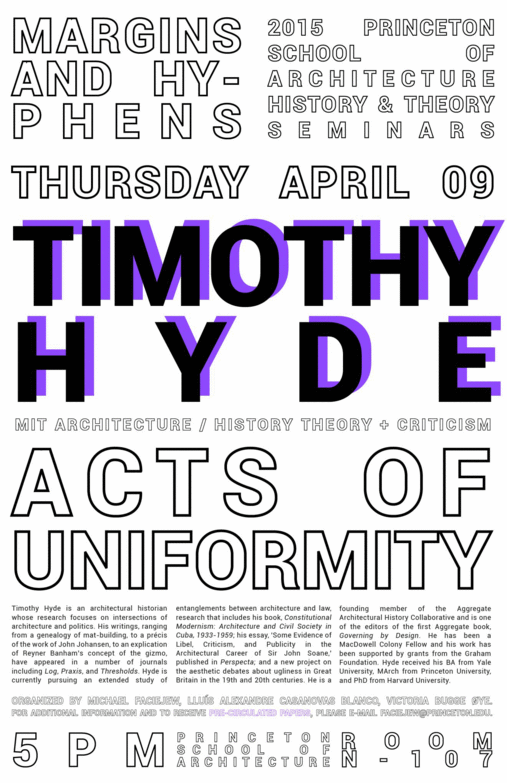Timothy Hyde: Acts of Uniformity
Thursday, April 9 / 5 pm / Room N-107
Timothy Hyde is an architectural historian whose research focuses on intersections of architecture and politics. His writings, ranging from a genealogy of mat-building, to a précis of the work of John Johansen, to an explication of Reyner Banham’s concept of the gizmo, have appeared in a number of journals including Log, Praxis, and Thresholds. Hyde is currently pursuing an extended study of entanglements between architecture and law, research that includes his book, Constitutional Modernism: Architecture and Civil Society in Cuba, 1933-1959; his essay, 'Some Evidence of Libel, Criticism, and Publicity in the Architectural Career of Sir John Soane,' published in Perspecta; and a new project on the aesthetic debates about ugliness in Great Britain in the 19th and 20th centuries. He is a founding member of the Aggregate Architectural History Collaborative and is one of the editors of the first Aggregate book, Governing by Design. He has been a MacDowell Colony Fellow and his work has been supported by grants from the Graham Foundation. Hyde received his BA from Yale University, MArch from Princeton University, and PhD from Harvard University.
This event is part of the Margins and Hyphens Seminar Series
Architectural histories and theories consistently aim for a radical redefinition of their role within broader discourses in the humanities. Acknowledging this persistent appetite for reassessment, this seminar series proposes to frame these concerns according to two basic formatting devices: the hyphen and the margin.
As defined in the Chicago Manual of Style’s section on “Manuscript Preparation Guidelines for Authors,” in order “to leave enough room for handwritten queries, margins of at least one inch should appear on all four sides of the hard copy” of a manuscript. In the most pragmatic sense, the margin serves as the necessary space for the expansion, clarification, and nuancing of the main body of a text. The margin is the liminal space in which a work is demarcated, challenged or even aligned with another entity. It is a critical distance.
On the other hand, the CMS stresses that the “only hyphens that should appear in the manuscript are hyphens that would appear regardless of where they appeared on the page.” Compound words alone, formed by a minimum of two distinct entities, allow for such orthographic figuration. The hyphen, a tool for juxtaposition, amalgamation, synthesis, facilitates the disciplinary frictions that texture the surfaces of architectural discourse.
Margins and hyphens—as spatial, epistemological, and formatting considerations—unavoidably shape documents. In Margins and Hyphens, we seek to bring into focus how they shape critical positions through the texture of writing itself.
Organized by Michael Faciejew, Lluís Alexandre Casanovas Blanco, Victoria Bugge Øye.
For additional information and to receive pre-circulated papers, please e-mail FACIEJEW@PRINCETON.EDU

